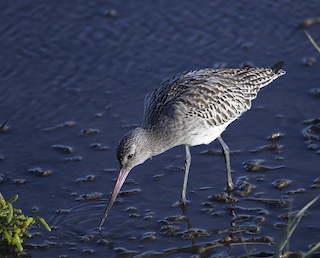 Look out for this long-beaked wader round the Lizard coastline in winter, or on passage in spring and autumn.
Look out for this long-beaked wader round the Lizard coastline in winter, or on passage in spring and autumn.
Photo: © Natural England/Allan Drewitt
Scientific name: Limosa lapponica
Conservation status: UK Birds of Conservation Concern, Amber; IUCN Red List, Least Concern
What to look for:
- Colouring and appearance: In breeding plumage, a chestnut brown on the breast and underparts, with the male an especially rich colour. Barred pattern on the tail, and black-streaked on sides, back and wings Its winter plumage is a duller grey-brown. Long bill, slightly upturned and with a pinkish base, and blueish-grey legs.
- Size: Length 38 cm, wingspan 75 cm.
- Where: Mudflats and tidal estuaries in the winter or on passage.
- Call: http://www.xeno-canto.org/58555
- Similar species: Black-tailed Godwit, which is distinguished by having an unbarred tail.
 The Bar-tailed Godwit catches the eye in the summer with its rich chestnut-brown breeding plumage. The females are less deeply-coloured but are still a slightly rufous shade. In the UK, however, we more often see this wader in its winter, non-breeding plumage. Over 40,000 of them overwinter with us in estuaries, but they breed in the Arctic tundra. Occasionally you might spot a non-breeding bird in the summer that hasn’t made the journey northwards, but otherwise this is a winter visitor or passage migrant.
The Bar-tailed Godwit catches the eye in the summer with its rich chestnut-brown breeding plumage. The females are less deeply-coloured but are still a slightly rufous shade. In the UK, however, we more often see this wader in its winter, non-breeding plumage. Over 40,000 of them overwinter with us in estuaries, but they breed in the Arctic tundra. Occasionally you might spot a non-breeding bird in the summer that hasn’t made the journey northwards, but otherwise this is a winter visitor or passage migrant.
Those birds that overwinter in the UK fly a fraction of the distance undertaken by others of the species. Many Bar-tailed Godwits fly to Africa, but birds of the subspecies that breeds in Alaska make it to Australia and New Zealand – a journey of almost 11,000 km in no more than seven days. What’s more, they do it non-stop, and without stopping to eat.
In the breeding season, the birds look for invertebrates on the tundra. In the non-breeding season, they forage for worms and crustaceans in the mudflats.
The grass-lined nests are made in the tundra moss, and both male and female tend to the clutch of up to four eggs and then the downy young after they hatch.
Did you know…?
…The maximum recorded age for a Bar-tailed Godwit is almost 34 years.
… Bar-tailed Godwits have the ability to reduce the size of their internal organs, so that they weigh less for their mammoth migration. This is more than balanced by the amount of fat reserves they need to take on to sustain them through the long flight.
More information and references:
Svensson, L., Mullarney, K., Zetterstrom, D.,1986. Collins Bird Guide, second edition (translated by Christie, D., Svensson, L.). HarperCollins, London.
Published: May 2015
Author: Amanda Scott
Photos: © Natural England/Allan Drewitt
